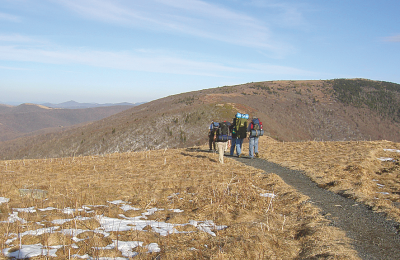A collaborative piece by Maureen Halsema, Kristina Tarsan of Southern Appalachia Highlands Conservancy, and Joseph Gatins of Georgia Forest Watch
Neither Cold nor Snow nor Sleet (nor Ice and Driving Winds!) Can Keep These Hikers Down
The crunch beneath your boots, a calming sense of solitude, a familiar landscape transformed. The world of winter hiking is unlike any other trail season—new vistas open up, new challenges present, even new trails too difficult to traverse in other seasons are suddenly open for exploration.
Roan Mountain in the Cherokee National Forest
Renowned for its exceptional biological diversity and outstanding beauty, Roan Mountain is one of the most magnificent places to explore.
Located on the North Carolina and Tennessee state line, Roan Mountain is a wonderful place to visit and hike any time of the year. Cross country skiing and snow-shoeing are a unique way to explore the trails during the winter as Roan gets more snow than almost any other location in the area. It is one of the highest ranges in the Southern Appalachians, with peaks topping out at over 6,200 feet.
Seventeen miles of the Appalachian Trail cross Roan Mountain, which traverse endangered, high-elevation ecosystems including spruce-fir forests and open grassy balds (the longest stretch in the world). The treeless mountaintops of the balds offer spectacular views and an alpine-like hiking experience.
In addition to the A.T., the Overmountain National Historic Victory Trail, which traces the famous route of mountain patriots during the Revolutionary War, crosses Roan Mountain.
Protected through the partnering efforts of the Southern Appalachian Highlands Conservancy (SAHC), the Appalachian Trail Conservancy and the U.S. Forest Service, conserving Roan Mountain was the initial effort of SAHC and remains today the organization’s flagship project.
Roan Mountain is located where NC 261 and TN 143 join on the NC/TN state line. Parking is located at Carvers Gap. To view more details about recreation on Roan Mountain visit the Cherokee National Forest website.
Holcomb Creek & Ammons Branch Falls in the Chattahoochee National Forest
This trek to an isolated section of national forest lands in the Cattahoochee National Forest, Rabon County, Ga., serves as introduction to the rich bio-diversity of Southern Appalachia.
A three-mile loop hike to two bold waterfalls, Holcomb Creek and Ammons Branch Falls—rated moderately strenuous for the novice, easy for the experienced hiker—has a total elevation gain of approximately 400 feet.
The trail bisects two crystal-clear trout streams and runs alongside stands of tall pines, hemlocks, rock faces and patches of native plants and ferns, including galax, pipsisewa, yellow root and saxifrage.
Dense stands of rhododendron, mountain laurel and doghobble are replacing the hemlocks falling prey to the current Hemlock Woolly Adelgid infestation and the white pines devastated by the Southern Pine Beetle.
The bonus for doing this hike in the dead of winter—assuming the mercury is at the right frigid temperature—is that both waterfalls and the rock faces will turn to ice, making for a spectacular and unusual display of nature.
Start your hike at the trailhead, located at the intersection of Hale Ridge Road (FS 7) and Overflow Creek Road (FS 86). Approach from Warwoman Road to the South, from North Carolina Route 246 to the North. You will descend on marked Forest Service trail (FS No. 52) to Holcomb Creek Falls will lead to a footbridge across a creek. Follow trail to Y intersection (right leads to Ammons Branch Falls overlook, left leads back a steady uphill to Hale Ridge Road.) Look for bonus cascade on left. Return to vehicles at trailhead (left along Hale Ridge Road.)
A few safety tips before embarking to this remote, but beautiful area: do not count on cell phone coverage, the last gas stations are in Clayton or Dillard, Ga., or Scaly, N.C., and hiking boots are recommended.
Backpacking Snow-Covered Mountains
By Stephen Otis
If you want a winter challenge, hike the Appalachian Trail through the Great Smokies, a 69-mile ridge walk along one of the most scenic sections on the entire A.T. Hiking trails in the midst of winter offers a certain beauty and solitude, unique from every other season.
Ryan Baxter, manager of Blue Ridge Mountain Sports in Knoxville, Tenn, recently hiked the Great Smokey ridgeline. “We only saw game tracks in the snow. We were breaking fresh trail the whole time,” Baxter said.
A rare treat, especially in Great Smoky Mountains National Park, the most visited park in the United States. Preparation is key when taking on the added challenges of snow, ice, and subfreezing weather.
“We focused on extraction, with multiple exit strategies to deal with things like weather on the mountain, injuries,supply shortages, or road closures,” Baxter said. An essential element of preparation is having the right supplies, such as food, crampons, and fuel.
“A good plan…and DOWN, lots of down; booties, bags and jackets,” Baxter added, “crucial to morale.” And with this morale in place, “you are surrounded by limitless potential.” For information about strategies and planning, visit: nps.gov/grsm
Related Articles
Latest News

Leave a comment
Your email address will not be published. Required fields are marked *






